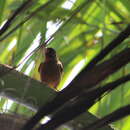en
names in breadcrumbs


The Príncipe seedeater (Crithagra rufobrunnea) is a species of finch in the family Fringillidae. It is found only on the islands of São Tomé and Príncipe off the west coast of Africa.[2] Its natural habitats are subtropical or tropical dry forest and subtropical or tropical moist lowland forest.[1]
The Príncipe seedeater was formerly placed in the genus Serinus but phylogenetic analysis using mitochondrial and nuclear DNA sequences found that the genus was polyphyletic.[3] The genus was therefore split and a number of species including the Príncipe seedeater were moved to the resurrected genus Crithagra.[4][5]
The Príncipe seedeater (Crithagra rufobrunnea) is a species of finch in the family Fringillidae. It is found only on the islands of São Tomé and Príncipe off the west coast of Africa. Its natural habitats are subtropical or tropical dry forest and subtropical or tropical moist lowland forest.
The Príncipe seedeater was formerly placed in the genus Serinus but phylogenetic analysis using mitochondrial and nuclear DNA sequences found that the genus was polyphyletic. The genus was therefore split and a number of species including the Príncipe seedeater were moved to the resurrected genus Crithagra.